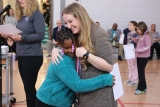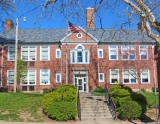-
Category 1
Selected in 2023
-
Grades: k - 4
School Setting: suburban
Town Population: 71,339
Student Enrollment: 171
Student Demographics:
Black/African American: 14%
Teacher/Student Ratio: 1:9
White/Caucasian: 69%
Hispanic: 8%
Hawaiian/Pacific Islander: 0%
Asian: 0%
Native American: 0%
Other: 9%
% Reduced Lunch: 35%
% ELL Learners: 7%
Founded: 1930 -
PRINCIPAL:
Julie Williams -
CONTACT:
625 S. 6th Street
St. Charles, MO 63301
636-443-4654
jwilliams@stcharlessd.org
Lincoln Elementary School
St. Charles, MO
“I am because we are.”
- 1. Tell us about your school’s success.
-
As a school we follow the African philosophy of Ubuntu, “I am because we are.” This way of living impacts all of our interactions with students, staff, and families. The way our staff interacts and supports each other, lays the foundation for how our staff supports our students and their families. Our interactions create a culture of trust, care, respect, and high expectations. When problems arise that have the potential to negatively impact our school culture, we all hold ourselves accountable to act with integrity and do what is best for the school community. Our dedication to maintaining a healthy culture produces outstanding results for the students, families, and staff at Lincoln. This culture creates lasting connections and relationships. Along with our positive culture, we also have high expectations that all our students will be successful. Because we see students as individuals, we are able to identify what they need to make progress and work as a team to ensure that they do.
- 2. Talk about the greatest contributing factor(s) that promoted positive change in your school.
- In 2008, Lincoln’s MAP scores were the lowest of the thirty elementary schools in the county. Morale was low and collective leadership was needed. Lincoln staff was working hard, but it was evident that we were all working hard, alone. The following year, we focused our efforts on fidelity, accountability, trust, and high expectations. Building wide, we added positive behavior supports and began rebuilding our school culture. Because of our collective leadership and empowerment, in 2012, Lincoln’s MAP results rose to the top three in the county. Our integrity, passion, and collective leadership is evident in our continued results, curriculum fidelity, transparency regarding student success, and willingness to be honest and undivided. We are passionate about working collectively to support all our students, and we have confidence in each other. We utilize this confidence and trust to make hard decisions. We remind ourselves that it’s the hard decisions that make us stronger.
- 3. How has ESEA funding supported the school's success?
- ESEA funding has supported our school success by affording us the opportunity to engage in professional development opportunities focused around the Science of Reading, LETRS training, and Restorative Practices. It has allowed us to provide time for planning days and data team meetings where our teachers work together to identify instructional needs and address these needs with intentional instruction and targeted interventions. ESEA funding has also allowed us to hire highly skilled interventionists to work with students on targeted interventions. These interventions are focused on individual students and small group needs. Our funding has allowed us to also hold community events where we invite families into our school to connect with our school community. We have hosted a variety of engaging community events that include: family pizza bingo nights, bowling events, pastries with parents, and more.
- 4. What professional development activities were used to improve teaching and learning?
- Staff identified three overarching behaviors we wanted to see in our school. From that meeting the Big 3 was born: Be Safe, Be Respectful, Be a Learner. Since that time, we have held true to our Big 3 and have added professional development to support the whole child and staff. Lincoln also implements Restorative Practices and Assessment Capable Learners. Our staff lead community circles as a way to enhance community and trust. Community circles are a part of all our faculty meetings and classrooms. Teachers work together as members of Professional Learning Communities. These PLCs utilize job embedded professional development to enhance student learning. One example of this is the current work with Assessment Capable Learners. Professional development about ACL is delivered to teachers during weekly PLC meetings and monthly data meetings. This professional development has provided us with a framework to work together to increase student achievement and foster professional culture.
- 5. Talk about the cultural shift leading up to your school's success.
- Before implementing our Big 3, sixty-eight percent of the student population visited the office with an office referral at least one time. This statistic mirrored the frustration felt by staff and students. Staff committed to Positive Behavior Supports. Our continued work within those expectations, and the addition of Ubuntu, students now feel safe, respected and ready to learn. Presently, our office referral rate is low and our student behavior is exceptional. Our predictable structures, dedication to building authentic relationships, and high expectations, are the foundation of our culture. The way that our staff interacts and supports each other lays the foundation for how our staff supports our students and families. Our interactions create a culture of trust, care, respect, and high expectations. These connections result in emotional safety felt by students and adults and high student academic achievement. Lincoln’s size may be small, but our impact is large.
- 6. How has community involvement strengthened your success?
- Our families and community stay connected through strong communication and authentic relationships. A variety of communication tools allow us to share news with our families, but we know that our relationships and the care we pour into their students are what keep us connected .Lincoln celebrates our students' academic results in our trimester awards assemblies and our annual MAP assembly. A testament to the family engagement at Lincoln is the one hundred percent attendance that we have each year at both fall and spring parent teacher conferences. Lincoln also partners with First St. Charles United Methodist Church. Through this partnership the church has donated over thirty thousand dollars. Their donations have allowed us to purchase books that represent our student population, elevate our music instruction, create a community garden, and host family events. First Church also donates backpacks of food to 15 fragile families to take home every Friday.
Stats
-
Category 1
Selected in 2023
-
Grades: k - 4
School Setting: suburban
Town Population: 71,339
Student Enrollment: 171
Student Demographics:
Black/African American: 14%
Teacher/Student Ratio: 1:9
White/Caucasian: 69%
Hispanic: 8%
Hawaiian/Pacific Islander: 0%
Asian: 0%
Native American: 0%
Other: 9%
% Reduced Lunch: 35%
% ELL Learners: 7%
Founded: 1930 -
PRINCIPAL:
Julie Williams -
CONTACT:
625 S. 6th Street
St. Charles, MO 63301
636-443-4654
jwilliams@stcharlessd.org







